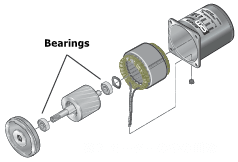Knowing how to use a product properly can make a huge difference in its performance and life. For example, knowing how to maintain cast iron pans properly can make them last longer. With electric motors, understanding the factors that affect motor life is the first step to extending life and decreasing costs in the long run.
First, what determines end of life?
Generally, end of life means when a product doesn't work anymore. However, what does it mean exactly?
End of life means when the speed, torque, accuracy, etc. stated in the specifications cannot be exhibited. This means that the motor still works, but cannot meet the specifications. If a product cannot meet its intended specifications, it cannot do the job. If it cannot do its job, it's "dead" to us.

Due to wear and tear, torque and speed will decrease when a motor approaches its end of life.
What are the main factors that affect life?
The life of a product is typically on the first component that fails. The 3 main components that are most likely to fail first are the bearings, gears, and circuit products, such as drivers and controllers.

Bearings

 |
Bearings are machine components that restrain unwanted motion and reduce friction between two moving parts. In a motor, the bearings support the load shaft and rotor. Since damage to bearings would cease operation for the motor, they are considered critical components. |
|
Standard motor operating life is estimated based on bearing grease life, which is affected by temperature. Exceeding the motor's specifications, such as radial (overhung) load and axial (thrust) load can also lead to a shorter life. Motors with long life bearing grease can extend their life to about 10,000 hours of operation. |
 |
Gears

Gears are used to either reduce the speed of a motor and to increase torque. Torque is multiplied by the gear ratio between the gears (and gear efficiency), and speed is reduced by the gear ratio. Similar to bearings, gears also handle the load directly, and they can wear out eventually; especially with impact loads, or if the motor specifications are exceeded. Once they are worn out, the motor can still work, but backlash and noise will not meet its specifications anymore.
Circuit Products

Circuit products include drivers, which supplies the logic and current to a stepper motor or servo motor, and controllers, which provide the logic instructions to the driver. The components within circuit products, such as an electrolytic capacitor, can fail due to high temperature. The life of a circuit product is based on the life of its electrolytic capacitor.
| TIP: How does temperature affect life exactly? | ||
|
So how can the heat rise be controlled?
There is a way to cool the heat source and a way to reduce the amount of heat generated by the heat source. To cool the heat source, a cooling fan, heat radiation (mount to a bigger metal plate, heat dissipation are all methods to reduce temperature. Reducing the operating temperature of motors can extend its life since the bearing grease will last longer. Reducing the operating temperature of motors can also increase its duty cycle. I've supported an application where a water circulated cooling jacket was used to increase the duty cycle of a stepper motor to near 100%.
The other approach is to reduce the energy loss at the motor. Since energy loss is generated in the form of heat, reducing energy loss would also reduce temperature. In this scenario, we can either use a high efficiency type motor or a continuous duty motor. For stepper motors and servo motors, reducing the motor current also reduces its operating temperature. This is because current is proportional to temperature. However, current is also proportional to torque, so it's ideal to reduce the current to a level that still generates enough torque, but at the lowest operating temperature possible.

Thanks for reading and please subscribe.
For more information about how temperature affects service life, rated life for different products, and how to actually calculate service life, here's a portion from the technical reference section of our catalog which explains deeper.
Interested in our cooling fans, high efficiency motors, or ways to reduce current?
Please contact our knowledgeable technical support engineers.



